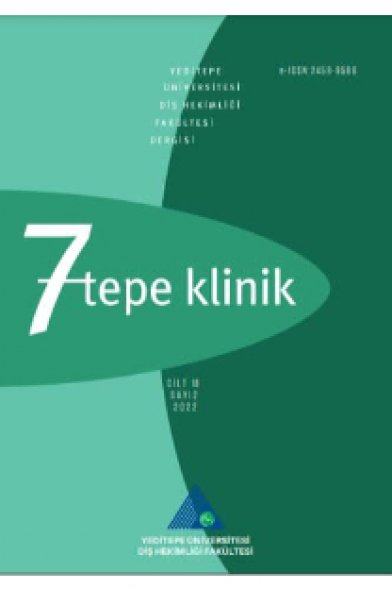Vertikal alveolar uzantılı modifiye nazoalveoler şekillendirme tedavisi: Olgu sunumu
Vertical alveolar stent added modified nasoalveolar molding therapy: Case report
___
- 1. Grayson BH, Maull D. Nasoalveolar molding for infants born with clefts of the lip, alveolus, and palate. Clin Plast Surg 2004; 31: 149-158.
- 2. Esenlik E, Beksiz JM, Gibsen T, Cutting CB, Grayson BH, et al. Preoperative alveolar segment position as a predictor of successful gingivoperioplasty in patients with unilateral cleft lip and palate. Plast Reconstr Surg 2018; 141: 1543-1548.
- 3. Yılmaz RB, Çakan DG, Noyan A. Comparison of oxygen saturation during impression taking before and after presurgical orthopedic therapy in babies with cleft lip and palate. Cleft Palate Craniofac J 2017; 54: 582-587.
- 4. Nur RB, Germeç Çakan D, Noyan D. Evaluation of oxygen saturation and heart rate during intraoral impression taking in infants with cleft lip and palate. J Craniofac Surg 2016; 27: e118-121.
- 5. Nur Yılmaz RB, Germeç-Çakan D, Mesgarzadeh N. Prevalence and managment of natal/neonatal teeth in cleft lip and palate patients. Eur J Dent 2016; 1: 54-58.
- 6. Fuchigami T, Kimura N, Kibe T, et al. Effects of pre-surgical nasoalveolar moulding on maxillary arch and nasal form in unilateral cleft lip and palate before lip surgery. Orthod Craniofac Surg 2017; 20: 209-215.
- 7. Ruiz-Escolano MG, Martinez- Plaza A, Fernandez-Valades R, et al. Nasolabäal molding therapy for the treatment of unilateral cleft lip and palate improves nasal symmetry and maxillary alveolar dimensions. J Craniofac Surg 2016; 27: 1978-1982.
- 8. Rubin MS, Clouston S, Ahmed MM, M Lowe K, Shetye PR, et al. Assessment of presurgical clefts and predicted surgical outcome in patients with and without nasoalveolar molding. Craniofac Surg 2015; 26: 71-75.
- 9. Patel PA, Rubin MS, Clouston S, Lalezaradeh F, Brecht LE, et al. Comparative study of early secondary nasal revisions and costs in patients with clefts treated with and without nasoalveolar molding. J Craniofac Surg 2015; 26: 1229-1233.
- 10. Nur Yımaz RB, Germeç Çakan D. Nasolabial morphology following nasoalveolar molding in unilateral cleft lip and palate. J Craniofac Surg 2018; 29: 1012-1016.
- 11. Sabarinath VP, Thombare P, Hazarey PV, et al. Changes in maxillary alveolar morphology with nasoalveolar molding. J Clin Pediatr Dent 2010; 35: 207-212.
- 12. Keçik D, Enacar A. Effects of nasoalveolar molding therapy on nasal and alveolar morphology in unilateral cleft lip and palate. J Craniofac Surg 2009; 20: 2075-2080.
- 13. Baek SH, Son WS. Difference in alveolar molding effect and growth in the cleft segments: 3-dimensional analysis of unilateral cleft lip and palate patients. Oral Surg Oral Med Oral Pathol Oral Radiol Endod 2006; 102:160-168.
- 14. Börnert H, Dannhauer K.-H, Schmalzried. Vertical changes in the position of the cleft segments of patients with unilateral cleft lip and palate. J Orofac Orthop/ Fortschr Kieferorthop 2002; 63:51-61.
- 15. Yu Q, Gong X, Shen G. CAD presurgical nasoalveolar molding effects on the maxillary morphology in infants with UCLP. Oral Surg Oral Med Oral Pathol Oral Radiol 2013; 116: 418-426.
- 16. Altay Burgaz M. Nazoalveolar şekillendirme tedavisi sonrasında transversal, sajital ve vertikal alveolar değişikliklerin üç boyutlu görüntüler üzerinde incelenmesi, Yeditepe Üniversitesi, doktora tez çalışması, 2016.
- 17. Dec W, Shetye PR, Davidson EH, et al. Presurgical nasoalveolar molding and primary gingivoperiosteoplasty reduce the need for bone grafting in patients with bilateral clefts. J Craniofac Surg 2013; 24:186-190.
- 18. Santiago PE, Grayson BH, Cutting CB, et al. Reduced need for alveolar bone grafting by presurgical orthopedics and primary gingivoperiosteoplasty. Cleft Palate Craniofac J 1998; 35: 77-80.
- 19. Grayson BH, Santiago PE, Brecht LE, et al. Presurgical nasoalveolar molding in infants with cleft lip and palate. Cleft Palate Craniofac J 1999; 36: 486-498.
- ISSN: 2458-9586
- Yayın Aralığı: Yılda 3 Sayı
- Başlangıç: 2005
- Yayıncı: Yeditepe Üniversitesi Rektörlüğü
Elçin KESKİN ÖZYER, ERKUT KAHRAMANOĞLU, Yasemin KULAK ÖZKAN
Vertikal alveolar uzantılı modifiye nazoalveoler şekillendirme tedavisi: Olgu sunumu
R. Burcu NUR YILMAZ, Derya ÇAKAN
Diabetes mellitus, periapikal enfeksiyon ve kök kanalı tedavisi ilişkisi
Güher BARUT, Beliz ÖZEL, Rabia Figen KAPTAN
Derya İÇÖZ, Hilal ÖZBEY, Burak Kerem APAYDIN
Sema AYDINOĞLU, İpek ARSLAN, Zeynep DEMİREZ
Aksesuar mezial kanala sahip alt büyük azı dişlerine endodontik yaklaşım: Olgu Serisi
Vahide Hazal YARGICI, Meriç KARAPINAR KAZANDAĞ, Rabia Figen KAPTAN
Farkli cila sistemlerinin kompozit rezinlerin yüzey pürüzlülükleri üzerine etkisi
Dilber BİLGİLİ, Ayşe DÜNDAR, Çağatay BARUTÇUGİL, İsmail Burak ÖCAL
Farklı kahve türlerinde bekletilen kompozit rezinlerin renk stabilitelerinin incelenmesi
Suzan CANGÜL, ÖZKAN ADIGÜZEL, Server ÜNAL, Samet TEKİN, Ezgi SONKAYA, Begüm ERPAÇA
Çocuklarda bilişsel seviye ve ağız diş sağlığı: Bir pilot çalışma
Müesser Ahu DURHAN, Seda ÖZSALİH, Mısra ÖZALP, Ömer Birkan AĞRALI, Hanife Nuray YILMAZ, Betül ŞEN YAVUZ, Betül KARGÜL
